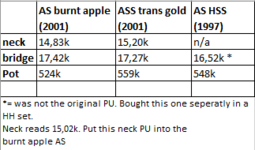dean701
Well-known member
Hey, just throwing this out there.
I have 2 EBMM Axis SS models that are painstakingly different sounding. One is a rosewood board and one is maple. I also have a Floyd as a reference. I have the Floyd guitar sounding exactly how I like it and I'm trying to get the others closer to it. The maple SS sounds way brighter (even than the Floyd) and the rosewood board sounds way darker than both.
Now to the actual question:
I measured the resistance of the pickups and the maple is 17.2K and the rosewood is 17.9K. I understand the rosewood/maple disparity but would this resistance variance have any bearing to the darker sound? The pickups are mounted to the same height. I'm going to swap them around since my OCD won't leave me alone but I just thought I'd ask. I have heard that more windings will be bring the bass and mids out more but these are the same model pickups so I was wondering if the resistance had a similar effect.
All in all, if I could get the maple SS to sound like the Floyd, I'd be done. The rosewood can be the odd one out.
I have 2 EBMM Axis SS models that are painstakingly different sounding. One is a rosewood board and one is maple. I also have a Floyd as a reference. I have the Floyd guitar sounding exactly how I like it and I'm trying to get the others closer to it. The maple SS sounds way brighter (even than the Floyd) and the rosewood board sounds way darker than both.
Now to the actual question:
I measured the resistance of the pickups and the maple is 17.2K and the rosewood is 17.9K. I understand the rosewood/maple disparity but would this resistance variance have any bearing to the darker sound? The pickups are mounted to the same height. I'm going to swap them around since my OCD won't leave me alone but I just thought I'd ask. I have heard that more windings will be bring the bass and mids out more but these are the same model pickups so I was wondering if the resistance had a similar effect.
All in all, if I could get the maple SS to sound like the Floyd, I'd be done. The rosewood can be the odd one out.
Last edited:



